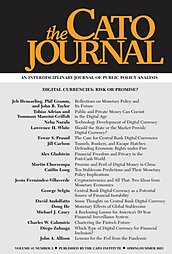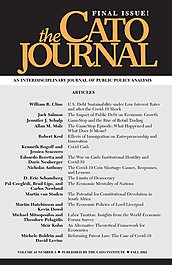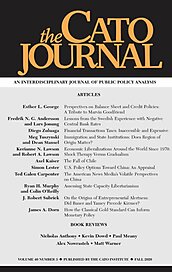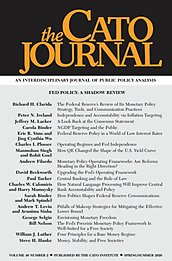Digital Currencies: Risk or Promise?
Articles
Editor’s Note
By considering potential benefits as well as possible risks of private and central bank digital currencies, the contributors to this volume improve our understanding of digital alternatives.
Reflections on Monetary Policy and Its Future
The Fed’s huge balance sheet allows it to engage in credit policy (the composition of the balance sheet is by definition credit policy), which inherently auto‐resides in fiscal policy — but should auto‐reside with Congress.
Public and Private Money Can Coexist in the Digital Age
Today’s world is characterized by a dual monetary system, involving privately issued money — by banks of all types, telecom companies, or specialized payment providers — built upon a foundation of publicly issued money — by central banks.
Technology Development of Digital Currency
Technology is incredibly important and influences what we can do with policy and what kinds of functionality we can even enable.
Should the State or the Market Provide Digital Currency?
The fact that the historical development of payment systems has been driven by private initiative, not state action, is often overlooked.
The Case for Central Bank Digital Currencies
The potentially transformative potential of cryptocurrencies was highlighted by Facebook’s 2019 announcement that it plans to issue a cryptocurrency called Libra, which would be backed by reserves of fiat currencies.
Tunnels, Bunkers, and Escape Hatches: Defending Economic Rights under Fire
It is unrealistic and unreasonable to expect that Venezuela, or any other state actor, will ever relinquish its hold over economic policymaking or its monopoly on money.
Financial Freedom and Privacy in the Post‐Cash World
[E]ven in liberal democracies where citizens can — in theory — protect themselves, corruption thrives and financial privacy is on the verge of extinction.
Promise and Peril of Digital Money in China
Digital currency and fintech have been some of the most powerful forces for freedom and personal liberty in China for the past decade, but their future influence is uncertain.
Ten Stablecoin Predictions and Their Monetary Policy Implications
End‐to‐end digital ways of transacting have suddenly replaced long‐entrenched analog ways of doing things.
Cryptocurrencies and All That: Two Ideas from Monetary Economics
Monetary economics must catch up with the new cryptocurrency landscape and help to shape it.
Central Bank Digital Currency as a Potential Source of Financial Instability
How could individual Fed accounts be destabilizing? Consider the case of a “classic” systemic financial crisis.
Some Thoughts on Central Bank Digital Currency
All the money we use today consists of bank liabilities, either private or central.
Monetary Effects of Global Stablecoins
Traditionally, the economic weight of a currency’s issuing country — along with its trade links, financial connections, and geopolitical stature, as well as the currency’s perceived safety and liquidity — explain why some currencies are used disproportionately in cross‐border transactions.
A Reckoning Looms for America’s 50‐Year Financial Surveillance System
[A]fter 50 years of the BSA, let’s try to measure its effectiveness.
Chartering the Fintech Future
With respect to technological changes, new methods for providing loans and payment services by “shadow banks,” especially by fintech banks over the past several years, are accelerating the long‐term trend of financial disintermediation from chartered banking by providing more attractive alternatives to customers.
Which Type of Digital Currency for Financial Inclusion?
America’s financial inclusion problem is usually expressed as the percentage of households — 5.4 percent at last count, according to the Federal Deposit Insurance Corporation (FDIC 2020: 1) — who lack a bank account.
Lessons for the Fed from the Pandemic
Despite the serious costs of the pandemic, the responses to it have reduced costly government regulations and speeded up the development of vaccines via the private sector and encouraged new technologies.
Book Reviews
Information Wars: How We Lost the Global Battle Against Disinformation and What We Can Do About It
By treating this loss of narrative control as inevitable, Stengel abdicates responsibility for his own failure to respond appropriately to his mistake and Russian attempts to seize upon it.
First Principles: What America’s Founders Learned from the Greeks and Romans and How That Shaped Our Country
Many Americans prioritized Rome’s example over Greece, but Thomas Jefferson stood out because of his unique commitment to Greek ideas, rejecting the Ciceronianism of people like Adams.
Recovering the Liberal Spirit: Nietzsche, Individuality, and Spiritual Freedom
Defenders of the liberal project have typically responded by doubling down on the twin benefits of wealth and choice.




